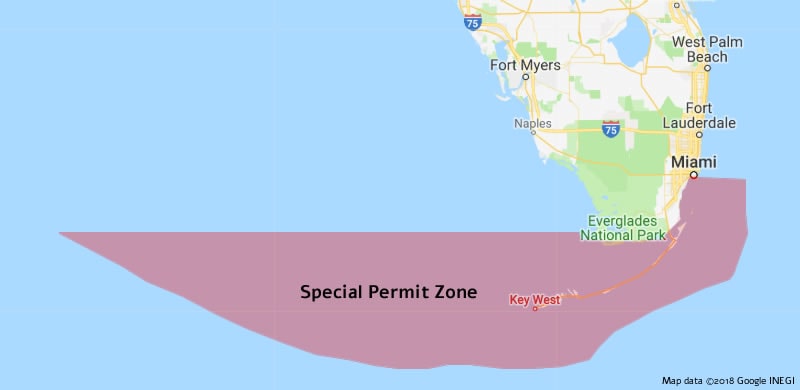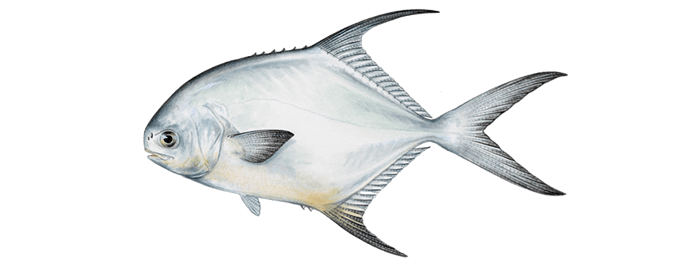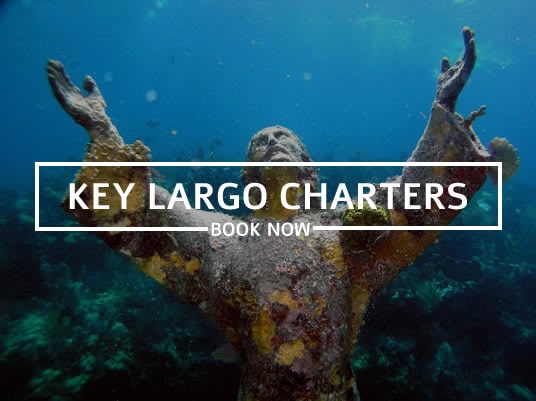Permit (Trachinotus falcatus)
Permits are one of the best game fish in Florida they are strong fighters and can go on long sprints across the shallow flats. Many unexperienced Anglers confuse the Permit for a Pompano. Permit are also referred to as Round Pompano and Great Pompano which makes the confusion between them even worst. Permits grow much larger than Pompano up to three feet in length and weigh more than 20 pounds. When they are smaller it is much harder to distinguish the two but small permits have orange patches on their chins, bellies, or fins and permits have yellow patches. Pompanos also have a narrower fork, sloped dorsal fin, a long anal fin that slops back and a hump in the forehead. They also have fewer rays on their dorsal and anal fins. They recently found a 23-year-old Permit that was 3 feet long. Permits have become a popular sport fish to target and they are also great to eat. They usually reproduce offshore above reefs anywhere between 33 to 100 feet deep. They can weigh as much as 50 pounds but the world record is 60 pounds. The largest Permit ever caught in Florida was 56 pounds and two ounces and was coaught near Fort Lauderdale. The average Permit you will catch is between 20 and 30 pounds.

How to catch Permit in Miami
The key to catching Permit is not letting them see you. They have large eyes and excellent vision. Permit fish are very skittish and will swim away at the first sight of movement. Using a light spinning rod is the rod of choice by most anglers going after Permit. You can also use a fly rod if you prefer that method but it is much more challenging to reel in a Permit on a fly rod. Using ten to twelve-pound fluorocarbon leader attached with a double uni knot to a 50-pound braid can also help catch more fish. The fluorocarbon is invisible in the water so the fish doesn’t see it. Once you feel a hit gently real the fish in and they will give you less resistance. In order to catch a Permit, you can use a small crab by hooking it on the side using a 2/0 J hook. You should keep the crab in the water until you see a Permit you want to target and then through the crab in front of it. When you hook a Permit get ready for a fight. These fish pull very hard and are known for their long hard runs. The key to landing a Permit is to keep tension on the line the whole time you are fighting the fish. You should also take any other lines out of the water because these fish are known to swim toward the boat and get tangled.
Where to fish for Permit
Florida is the only place to catch Permits on the flats in the United States. Permits can also be found near sand flats, deep channels, holes inshore, in the surf, inlets, offshore wrecks, oil platforms, as well as around artificial reefs. The best place to fish for Permit is in South Florida from Dade County to the Florida Keys. In the summer they go into deeper reefs around the South Atlantic. If your fishing in shallow water you want to target depth you want to target is between 3 feet and 50 feet. When they are in the shallows they are skittish because they know they’re vulnerable to predators. The only reason they come to the flats is to snack on their favorite little crabs or lobsters. Look for piles of rock, sandy holes channel markers and channels. Permits feel more comfortable around offshore wrecks and reefs. They’re much more likely to grab your bait in this environment. In order to catch Permit in the shallows, you will need a Bay boat with an electric motor, a flats boat with a pole, or a kayak. There are plenty of Permit fishing charters in Miami available.
Best time of the year to fish for Permit in Miami
During Permit, pre-spawn months starting in late February is a great time to target decent sized Permit in the Florida Keys flats. March is the best month to fish for Permit in the Florida Keys flats. From late February until early April the Permits come into the backcountry and flats of the Keys and you can catch Permit that are anywhere between 10 and 40 pounds. At the end of April and May, they start to move offshore to spawn near structures like wrecks and reeds. In winter and springtime, the rough and windy conditions limit the fishes visibility making it more likely that they will go after your bait in the flats. During Summer is when Permit is most available but you will have to go offshore where they will be hanging out above wrecks and reefs. Trying to fish for Permit in the flats during summer is more difficult because the clear conditions make them more skittish and harder to catch. June and July are also good times because the Permits are coming back into the flats after spawning offshore. They can also be caught in the fall season from late September until the beginning of November when the cold weather pushes them back into the flats to search for small crabs.
The best bait to catch Permit
The best bait to catch Permit is any small live crab or a large live shrimp with a split shot. Casting a small live crab in the path of a Permit will almost guarantee you a bite. They will also eat dead pieces of crab and lobster at times. If you want a challenge then you can also catch them using white, yellow or black wiggle jigs or flat head jigs. Soft plastic crab lures can also work at times but you will get many more hookups with a live crab. The DOA Softshell Crab or Berkley Gulp! Saltwater Peeler Crab are both great options for fake crab lures. Artificial shrimp are also effective on a jig if you run out of live crabs and want to continue fishing. If you’re using artificial shrimp then the Almost Alive Rigged Shrimp, Egret Baits Vudu Shrimp, and the Berkley Gulp! Hollow Shrimp are all great options. Stick to colors that mimic the live bait in the area. The key to plastics and fly’s is to make sure that your lure looks and acts like the real thing. These lures are not as effective as live crabs because Permits have huge eyes and can spot a fake from a mile away. Practice makes perfect when using lures so going out as much as you can.

Florida Permit fishing regulations
In State and Federal waters outside the Permit zone, they can be caught year round. However, in the Special Permit Zone, they can only be kept during Permit season from August 1st until March 31st. If you catch a Permit in the Special Permit Zone(SPZ) then they cannot be less than 22″ but anywhere outside of the zone they need to be between 11 inches and 22 inches. The bag limit inside of the SPZ is one per person and two per person outside of the zone. The SPZ includes state and federal waters south of Cape Florida in the Atlantic and south of Cape Sable in the Gulf as well. A current Florida saltwater fishing license is required to fish for all types of saltwater species in Florida including Dolphin. Before going fishing make sure you can obtain a license from the Florida Fish and Wildlife Conservation Commission by going online, calling or going to a bait and tackle shop. If you’re going on a fishing Charter in Florida then chances are it’s included with the booking fee. Florida residents who are fishing from shore, bridges or piers can get a recreational saltwater shoreline fishing license, which is free of charge.












